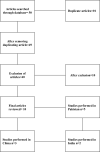Role of Parenting and Psychosocial Correlates Contributing to Social Anxiety in Asian Adolescents: A Systematic Review
- PMID: 37817814
- PMCID: PMC10561979
Role of Parenting and Psychosocial Correlates Contributing to Social Anxiety in Asian Adolescents: A Systematic Review
Abstract
Background: The purpose of the study was to explore social anxiety in adolescents as well as associated factors, such as parenting styles, self-esteem, quality of life, emotional intelligence, and brain activity, in social anxiety.
Methods: A systematic review of articles related to social anxiety in adolescents, associated factors, and brain activity from 2012 to 2022 was performed. Google Scholar, PubMed, and Science Direct were used as research gates to find the relevant articles.
Results: Ten articles were sorted among 50 articles according to inclusion criteria. The included studies were based in Pakistan, India, and China, which indicated similar results. Social anxiety was directly related to low self-esteem, authoritarian parenting style, interbrain synchrony between parents and adolescents, low quality of life, weak emotional intelligence, and higher activity in the amygdala of the brain.
Conclusion: Social anxiety is common in male-dominant (patriarchal) societies where authoritarian parenting is practiced, which leads to low self-esteem, weak emotional intelligence, and low quality of life in adolescents. Social anxiety is also associated with higher activity in the amygdala and lower gamma interbrain synchrony.
Keywords: Social anxiety; adolescence; amygdala; attention bias; emotional processing; parenting style; quality of life; self-esteem.
Copyright © 2023. Matrix Medical Communications. All rights reserved.
Conflict of interest statement
DISCLOSURES: The authors have no conflicts of interest relevant to the content of this article.
Figures
Similar articles
-
Chronic Pain in Adolescents: The Predictive Role of Emotional Intelligence, Self-Esteem and Parenting Style.Int J Community Based Nurs Midwifery. 2020 Jul;8(3):253-263. doi: 10.30476/ijcbnm.2020.83153.1129. Int J Community Based Nurs Midwifery. 2020. PMID: 32656277 Free PMC article.
-
Understanding the relationship between parenting style and chronic pain in adolescents: a structural equation modelling approach.BMC Psychol. 2021 Dec 24;9(1):201. doi: 10.1186/s40359-021-00704-5. BMC Psychol. 2021. PMID: 34952639 Free PMC article.
-
Mediating effects of self-esteem on the relationship between mindful parenting and social anxiety level in Chinese adolescents.Medicine (Baltimore). 2022 Dec 9;101(49):e32103. doi: 10.1097/MD.0000000000032103. Medicine (Baltimore). 2022. PMID: 36626511 Free PMC article.
-
Meta-analysis of the effectiveness of parenting programmes in improving maternal psychosocial health.Br J Gen Pract. 2002 Mar;52(476):223-33. Br J Gen Pract. 2002. PMID: 12030667 Free PMC article. Review.
-
Parenting practices in childhood and depression, anxiety, and internalizing symptoms in adolescence: a systematic review.Soc Psychiatry Psychiatr Epidemiol. 2021 Apr;56(4):619-638. doi: 10.1007/s00127-020-01956-z. Epub 2020 Sep 5. Soc Psychiatry Psychiatr Epidemiol. 2021. PMID: 32892249
Cited by
-
Obsessive-compulsive symptoms as a unique presentation of complex posttraumatic stress disorder in Southeast Asia: a case report.J Med Case Rep. 2025 May 31;19(1):261. doi: 10.1186/s13256-025-05323-x. J Med Case Rep. 2025. PMID: 40450372 Free PMC article.
References
-
- Kehoe WA. Generalized anxiety disorder. In: Dong BJ, Elliott DP, eds. ACSAP 2017 Book 2 Neurologic/Psychiatric Care. 2017. pp. 7–27. American College of Clinical Pharmacy.
-
- Alonso J, Angermeyer MC, Bernert S et al. Prevalence of mental disorders in Europe: results from the European Study of the Epidemiology of Mental Disorders (ESEMeD) project. Acta Psychiatr Scand Suppl. 2004;420:21–27. - PubMed
-
- Shen Y-C, Zhang M-Y, Huang Y-Q et al. Twelve-month prevalence, severity, and unmet need for treatment of mental disorders in metropolitan China. Psychol Med. 2006;36(2):257–267. - PubMed
Publication types
LinkOut - more resources
Full Text Sources

